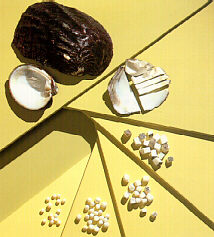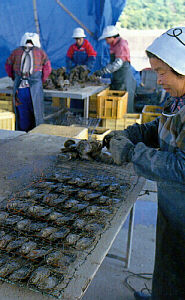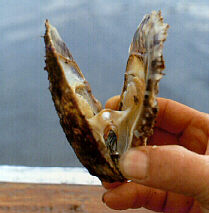
 |
![]()
 |  |  |
Generally speaking, all cultured pearls are cultivated in the same manner. Only certain elements of the process vary according to the type of oyster or mussel being used and, hence, the type of pearl obtained.
The cultivation process begins with the mother oyster being carefully brought up from its growing environment. The oyster is very gently opened, and kept open with the help of small wooden wedges. A sliver of tissue (called "mantle") is taken from another living pearl oyster of the same species. Both the mother and donor oyster must be chosen with care, as it is only from perfect mollusks that pearls of the highest quality are likely to result.
This mantle tissue is finely sliced and a tiny section carefully inserted into a channel made in the soft tissue of the mother oyster by a surgical scalpel. In most cases, a nucleus is added at the same time. This is usually a small, spherical, mother-of-pearl bead made from the shell of freshwater mussels that come from either the United States or China.
Simple as this operation may sound, it is actually a very delicate procedure. The skill of the technician directly reflects upon the quality of the pearl eventually produced and the quantity of pearls harvested.
The oyster is then returned to its growth environment. Within two weeks, under optimum conditions, living graft tissue will have formed a pearl sac around the nucleus within which a perfect pearl will, hopefully, begin to grow.
 From this point on, even greater care is taken with the oyster. Since it is vulnerable to parasites and other underwater growths, each shell is cleaned at regular intervals.
From this point on, even greater care is taken with the oyster. Since it is vulnerable to parasites and other underwater growths, each shell is cleaned at regular intervals.
Because oysters are such extremely delicate creatures, the pearl farmer must take many other factors into account over the long cultivation period: the depth at which the oysters are suspended, water conditions such as temperature, salinity, currents and flow of plankton, plus predators, pollution and changing weather conditions, to name but a few.
The length of the cultivation period varies according to the type of mother oyster and the geographical location of the pearl farm. Generally speaking, however, it takes up to two or three years for an oyster to produce a pearl, although some species are harvested annually.
 | This then, is how pearls are cultivated. With systematic expertise acquired over many decades of effort. With great care and skill. And, always, with the beneficence of Mother Nature and Lady Luck. |